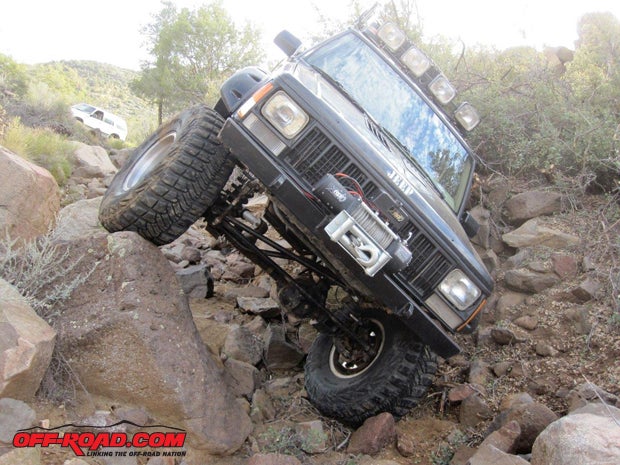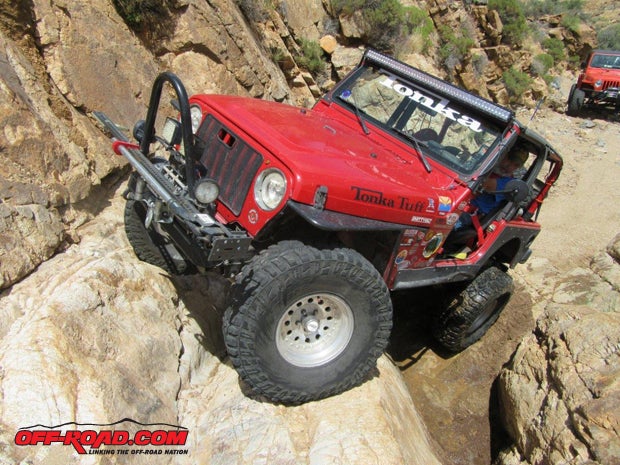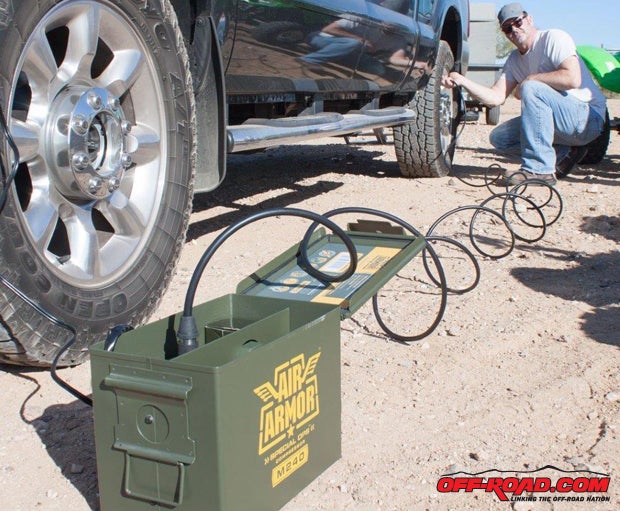
In your Jeep Creep questions, please list your first and last names, your hometown, and your state/province/country, so that we can publish that information here. If you don’t provide this information, we may not be able to publish your question and answer. Don’t forget to be as complete as possible with the description of your Jeep and its problems, too. Send your Jeep questions to editor@off-road.com, Attn: Jeep Creep.
Previous Jeep Creep Columns
Jeep Recall Update, Manual Hubs, JK Wrangler Lift Kits
Jeep Q&A: CB Antenna Fix, Hi-Lift Jack Mounting, Scrambler Pickup
Jeep Creep: Wrangler, Cherokee, Grand Cherokee Questions Answered
No Jeep recalls from NHTSA this month

Inclinometer
I mounted an inclinometer above my mirror and it looks pretty impressive. I’ve tried using it on some of the trails around here but I’m nervous about how far over my Jeep can tip before I’m in real trouble. Also, my wife has become fascinated with it since she can see it from her seat. She keeps asking me, “When should I get worried?” If you can, tell me what’s the angle that I can lean before it goes on over?
Bill “Rocky” Stone
Mesa, AZ
I receive a query about an inclinometer about once a year, on average. And I’ve been receiving them now for nearly 40 years. I usually just say something along the lines that when a driver is concerned about what the inclinometer is showing, the Jeep is probably already too far over. Or, the driver should be watching the trail and not the inclinometer. But since your wife asked, Rocky, here goes: First, you didn’t tell me what model Jeep you have and what mods have been done, so I’ll explain what happens. Center of gravity—or CG—is determined by a formula that includes Jeep weight, height and width (outside of tire to outside of tire), and speed if you happen to be going around a corner. When you add a lift kit to the Jeep and raise it, the CG raises too. But when you put on wider tires on wider rims, the CG goes back down. If you look at the photo of the Cherokee, you’ll see that a Jeep can lean way past the angle you’d think would be critical and still not roll over. In other words, you’ll never know ahead of time when you’ll roll until you roll. You could be leaning far over and be fine until you roll forward off a relatively small rock and lay it over. Please tell your wife that she’ll have a lot more fun watching the flora and fauna instead of the inclinometer.

Lockers
I recently read the article on when to use high and low range while four wheeling. It was very interesting and informative, but it started me thinking about lockers. I’ve had a 2008 Rubicon for about a year, and I’ve used the lockers a few times. How come I can’t use the lockers in high range? I don’t like the way the steering acts when the front locker is in so I don’t normally use it except in really soft stuff. I’ve noticed the tires chirping when I’m driving over solid rock when the rear locker is engaged. Why is that? And why does the steering feel funny when the front locker is engaged?
Lionel “Night-train” Robbinet
San Diego, CA
It seems like this month is my month for explanations so here goes with the first question. Lionel, the reason you can’t use your Rubicon’s lockers in high range is a safety thing with Jeep. It could also be a warranty issue because aftermarket lockers such as Detroit and ARB have no such restrictions. Secondly, Lionel, your steering feels wonky when under power while the locker is engaged because the locker is trying to straighten the front wheels out. You see, with a locker, when a vehicle is under power and moving forward, both axles are locked in position and turn at the same speed. This means each driven wheel is getting approximately the same amount of traction, regardless whether it’s a front or rear axle. This is also the reason the rear tires will “chirp” when on solid rock—the outside tire is trying to cover a greater distance than the inside tire, therefore, the inside tire skids or chirps to make up the distance. The red Jeep is climbing the “gatekeeper” on a local Kingman, Arizona, trail. Without lockers, it’s effectively in two-wheel drive—one wheel on each axle—and would be unable to climb the obstacle. With all four tires pulling evenly, the Jeep can overcome the obstacle.

Air Compressors
Just bought a 2016 Rubicon Unlimited and I’ve taken it out a few times. I’ve been told that letting air out of the tires while on the trail helps the Jeep’s traction. Why is that? How low should I go? What do I do when I get back to the pavement? I don’t want to drive on the highway with low tires—and the Jeep’s computer doesn’t like it either.
Katherine Herridge
Sacramento, CA
Welcome to the chaos, Katherine. You’ve just joined a fantastic sport, so congratulations on that and on your choice of vehicles. You’re starting out right! First of all, lower tire pressures do a number of things on the trail. Lower pressure provides a softer suspension, which means an easier ride. Lower air pressure spreads the tire tread outward—that’s fore and aft and to both sides—which gives the tire a much bigger footprint and also equals much better traction. However, lower air pressures also create more heat, and heat causes the tire’s compound to break down more quickly. This is why you want to pump up your tires before traveling any longer distances on the highway, Katherine. Although, I will suggest your first modification should be taller tires, especially if you smartly opted for the 4.10:1 gear ratio rather than the mall crawler 3.73:1 ratio. Your OEM LT255x75x17 tires are 30 inches in diameter, which doesn’t give your differential cases a lot of ground clearance. Earlier model Rubicons were delivered with 32-inch tires—or LT285 tires—which, in my opinion, should be considered as your minimum height when you upgrade your tires. As far as pumping air into your tires, I’ve owned many, many air compressors over five decades of four wheeling and two of the best come from SuperFlow, the MV90 and M240. The M240, which is built into its own toolbox, is ideal for you and will be until you exceed 35-inch tires on your Jeep. We actually tested both air compressors. The M240 pumped a 35x12.50x17 Yokohama Geolandar M/T from 10 psi to 35 psi in an average time of 4 minutes/53 seconds, with a 5- to 10-minute cool-down between each of the three tests. For your friends, Katherine, with even bigger tires than 35 inches, we also tested the MV90. SuperFlow claims that the MV90 can pump up a 40-inch off-road tire in about five minutes. Well, we didn’t have a 40-incher but we did have a set of 37x12.50x17 tires, so we tested the MV90 on the left front tire. Theoretically, it may take longer to pump up a tire that’s supporting a Jeep truck and a Chevy 350 V8 than it would a tire that’s not supporting any weight other than its own. Although the times varied slightly, the average was 5 minutes, 38.5 seconds. That’s a pretty good time.
Sensor Sensing
I own a ‘93 Jeep XJ Sport 4.0 4x4 and I am having some issues with it. When I crank it up (cold or hot) it does not want to run well above 2,200 rpm. I have replaced the CPS, fuel pump, fuel filter, and most of the sensors (minus the TPS, knock and MAP). I replaced the sensor in the distributor and installed new plugs, wires, cap and button, and the fuel pressure regulator. The O2 sensor was replaced 4-5 years ago. I put a timing light on it. It will not idle at 0 degrees; it goes 2-4 degrees toward bottom of the engine. I have a hole in my exhaust manifold. My wife is upset because I keep putting money into it and not getting any results. I can’t get rid of it; it’s too close to me. And it’s not throwing any codes.
Larry Sutton
Long Beach, CA
Make sure it is not running rich and that the exhaust is not restricted. Make sure the air intake is not restricted--dirty filter, crimped intake tube, etc. Is the “check engine” light on and does the light work? I think you also need to replace the O2 sensor. When I still lived in California, I had to replace the O2 sensor every other year before my Scrambler would pass the bi-annual smog test, so you’ll probably have to replace it as well.
Engine Codes
I’ve got a P1195 check engine code. I think my O2 sensor needs some attention. Do I need to replace it? If so how do I do this?
Jim Peoples
Houston, TX
A typical O2 sensor will last 100,000 miles, however, as I said earlier, when I still lived in California I had to replace the O2 sensor every other year before my Scrambler would pass the bi-annual smog test. You’ll find the instructions for replacing the O2 sensor in a Haynes or Chilton shop manual for your model Jeep (available in any auto parts store).
Zipper Maintenance
I have been thinking for a while now that some kind of zipper lubricant would help because getting in the back of my CJ7 is getting to be a pain. What works best and how do I apply it? Can I get the lubricant on the cloth that the teeth are attached to or if not? How would I put it on the teeth? I found someone selling “Zipperease” for Jeep zipper repair on EBay. I researched Zipperease and discovered that it is a wax-based stick that is sold primarily to divers for use on wet/dry suit zippers. I went to my local dive store, bought some for a couple dollars and applied it to the zipper on my door and it works great. Plus the zipper is quiet now as a result of the compound. According to the label, the compound is stain free.
Guy Seemly
Jackson, MS
There may be a better lubricant, but I prefer spray silicone. It goes on dry, doesn’t attract dirt and dust, and lubes very well. However, you may have to apply it every month or so. If you go to Bestop’s website, you can find their zipper lube. I have a feeling your door window zipper is going to be covered with dirt after your next trail ride. The wax may work wonders in a wet, dust-free environment, but on the trail I think it’s going attract dust like a magnet does iron filings. Silicone spray is available at any auto parts store.
Axle Adjustments
I was just wondering what is involved with flipping your axles under your springs? Do you have to change steering geometry or driveshaft angles? Also, what is the best way to free up a sticking lifter? Is there an additive that works best?
Charley Wittmore
Vancouver, BC, Canada
What you are talking about is called “SOA” or spring-over-axle conversion. You may have to do both, change your steering geometry and driveshaft angles. However, you may not have to change driveshafts. The best way to free a sticking lifter is to change it, although there are some good additives designed to free up hydraulic lifters—check at your local Napa or O’Reilly auto parts store. The next best way is to change your oil to ATF. Do not drive it with ATF in the crankcase, just allow the engine to idle, reach its full warm-up temperature, and then do some easy revs. Change the oil back to engine oil (preferably synthetic) and change the filter, too. Add a can of Marvel Mystery Oil and you should be OK. Don’t overfill the crankcase, though.
Skunk Works
Our Jeep had a skunk-like smell; it was really noticeable when the heater was on. Is this something we should be concerned about? What could it be? The smell was inside and outside, plus it came out of the heater. It seems to have only happened the one time and now we are thinking maybe there was skunk in the area.
Ray Phillips
Bainbridge Island, WN
If it happened while you were driving, you probably either hit a skunk or just missed it. Be thankful it didn’t spray your exhaust or you’d have to change the exhaust or get rid of the Jeep!
In your Jeep Creep questions, please list your first and last names, your hometown, and your state/province/country, so that we can publish that information here. If you don’t provide this information, we may not be able to publish your question and answer. Don’t forget to be as complete as possible with the description of your Jeep and its problems, too. For some reason the questions have fallen off, and I know we haven’t answered all your Jeep technical questions. There are no dumb questions; only unasked questions. Send them in and try to stump us.—Jim Brightly
As usual, each month, I’m shouting out a huge THANK YOU to Paul Schupp at Rock Lizard 4x4 in Kingman, Arizona, for his invaluable assistance in answering many of the Jeep Creep questions.
Previous Jeep Creep Columns
Jeep Q&A: Jeep Recall Update, Manual Hubs, JK Wrangler Lift Kits
Jeep Q&A: CB Antenna Fix, Hi-Lift Jack Mounting, Scrambler Pickup
Jeep Creep: Wrangler, Cherokee, Grand Cherokee Questions Answered


 Your Privacy Choices
Your Privacy Choices